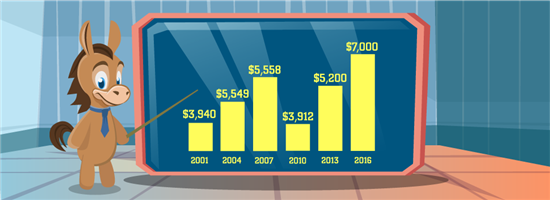Average Savings Account Balance
How much does the average person have in their bank savings account? Read on to find out, including breakdowns by age and state.
 |
| © CreditDonkey |
MEDIAN SAVINGS ACCOUNT BALANCE
Americans have a median of $7,000 in their savings accounts. Here's how that total has changed since 2001:
- 2016: $7,000
- 2013: $5,200
- 2010: $3,912
- 2007: $5,558
- 2004: $5,549
- 2001: $3,940
While average and median savings account balances estimate the same thing, the results are often very different. Why?
An average takes the sum of a list of figures and divides that by the number of figures on the list. As such, an average balance will include very high or very low balances that can skew results.
A median balance takes the number closest to the middle in a given set of figures.
Read on for a breakdown of average account balances.
- Average Savings Account Balance by Age
- Median Account Balance by Age
- Average Savings Account Balance by Income
- Median Account Balance by Income
- Average Savings Account Balance by Gender
- Median Account Balance by Gender
- Average Savings Account Balance by Race
- Median Account Balance by Race
- How Much Should You Save?
- How to Save More Money
- Where Should You Keep Your Savings?
AVERAGE SAVINGS ACCOUNT BALANCE BY AGE
Americans generally add more money to their savings accounts as they age. Here's a breakdown by age, according to the SCF:
- Under 35: $8,362
- 35–44: $20,839
- 45–54: $30,441
- 55–64: $45,133
- 65–74: $54,089
- 75 and above: $42,291
MEDIAN SAVINGS ACCOUNT BALANCE BY AGE
The median savings account balance by age shows a similar upward trend as people age. However, the amount of money is significantly lower than the average savings balances.
Here's a breakdown by age:
- Under 35: $2,600
- 35–44: $3,800
- 45–54: $4,100
- 55–64: $5,400
- 65–74: $8,000
- 75 and above: $10,000
AVERAGE SAVINGS ACCOUNT BALANCE BY INCOME
Income is one of the largest factors when it comes to savings account balances. Households that make over $160,000 annually have much more saved that those in lower-income brackets.
Here are the numbers:
- Less than $25,000: $6,021
- $25,000–$44,999: $11,719
- $45,000–$69,999: $13,179
- $70,000–$114,999: $15,333
- $115,000–$159,999: $37,645
- More than $160,000: $117,771
MEDIAN SAVINGS ACCOUNT BALANCE BY INCOME
Here's a full breakdown of median savings account balance by percentile income.
- Bottom 20th percentile: $600
- 20.00 to 39.99 percentile: $1,700
- 40.00 to 59.99 percentile: $3,800
- 60.00 to 79.99 percentile: $8,200
- 80.00 to 89.99 percentile: $18,700
- The top 10 percentile: $62,000
AVERAGE SAVINGS ACCOUNT BALANCE BY GENDER
Women reported an average of $16,986 in their savings accounts. Meanwhile, men reported having an average of $34,942 in their savings accounts.
Households with men listed as a primary breadwinner earned more than households headed up by women.
MEDIAN SAVINGS ACCOUNT BALANCE BY GENDER
The breakdown of median savings account balances by gender shows a more dramatic difference between men and women, according to the statistics.
Women had a median of $2,500 in their savings account balance. Men had a median of $9,200 in their savings accounts.
Before drawing conclusions from this data set, it's important to look at some of the other factors that may affect the data. For example, mostly men headed 80% of the households that took the survey. This can skew the sample size, or it can be seen as a reflection of society.
AVERAGE SAVINGS ACCOUNT BALANCE BY RACE
The Survey of Consumer Finances also collects data by race. Here's a breakdown of the data:
- Black: $10,479
- Hispanic: $24,743
- White: $33,879
- Other: $48,257
The "other" category consists of several races, including Asian, American Indian, Alaska Native, Pacific Islander, and more, according to the Survey of Consumer Finances.
MEDIAN SAVINGS ACCOUNT BALANCE BY RACE
Compared to the average savings account balances separated by race, the median balance is much lower. That's because outliers do not skew the numbers as much.
Here is a breakdown of median savings account balances by race, according to the Survey of Consumer Finances:
- Black: $1,500
- Hispanic: $1,510
- White: $9,700
- Other: $12,800
HOW MUCH SHOULD YOU SAVE?
Though age or income breakdowns can serve as a guide, there's no set amount you should be saving. Consider your own personal situation and your own personal finances to find a goal that feels reasonable.
You can also try a budgeting plan, like the 50/30/20 rule. Here's how it works:
- 50% of your budget goes to fixed expenses, like rent or utilities
- 30% goes to non-essential expenses, like gym membership, subscriptions, or eating out
- The last 20% goes toward savings
Using a budgeting method like this can help you reach your savings goals and keep better track of your spending.
An emergency (or "rainy day") fund is money that can be accessed instantly rather than tied up in investments or a long-term savings account like CDs. Consider setting aside 6 months of monthly expenses, ideally in a high-yield savings account.
HOW TO SAVE MORE MONEY
Putting aside money each paycheck (or every month) is a great start to increase your savings account balance. Here are some ways to grow your savings even further:
- Open a CD
If you have a chunk of money you won't need for a while, consider a certificate of deposit. You may earn a higher guaranteed interest rate than a regular savings account. But you'll be penalized for withdrawing your funds before the term ends. - Consider Investing
Unlike with a savings account, investing in stock, bonds, or mutual funds carries risk. But they can generate a much higher return. - Contact a Fiduciary
Speaking with a registered fiduciary, who is legally required to act in your best interests, can help you better figure out your financial situation and grow your savings account.
WHERE SHOULD YOU KEEP YOUR SAVINGS?
Finding the right type of savings will have a big impact on how much you can save. Here are a couple of factors to consider:
- Fees
Be sure to read the fine print and understand all charges associated with your account. These may include monthly maintenance fees, out-of-network ATM fees, overdraft charges, and more. - Interest Rates
An interest rate is a percentage you earn on the total amount in your savings account. A higher interest rate means your money will grow faster. Generally, online banks offer the best rates, since they avoid overhead expenses associated with maintaining physical branch locations.
THE BOTTOM LINE
The average savings account balance can be a helpful guide to track your own savings. But remember, every person is different. Rather than compare your savings to others, it's best to focus on creating a budget to help you reach your goals.
Write to Samantha Tatro at feedback@creditdonkey.com. Follow us on Twitter and Facebook for our latest posts.
|
|
|









